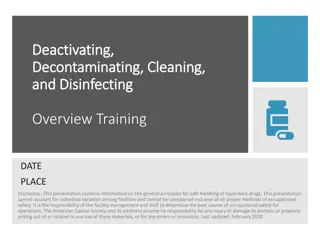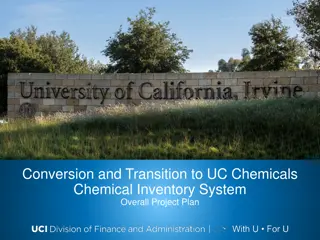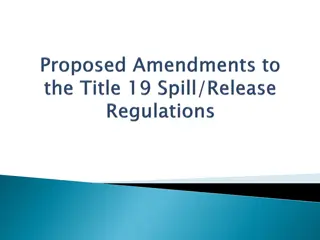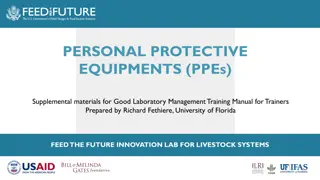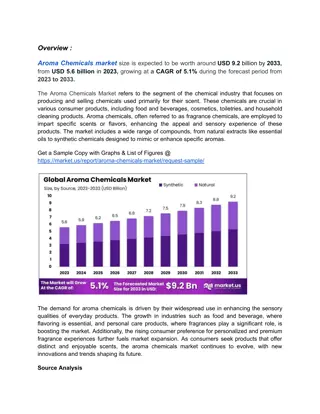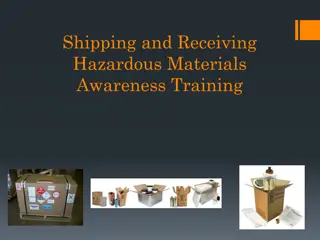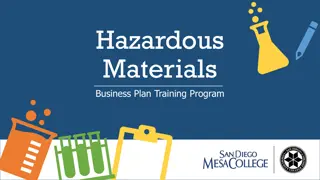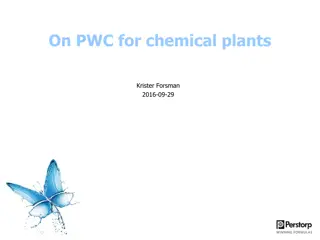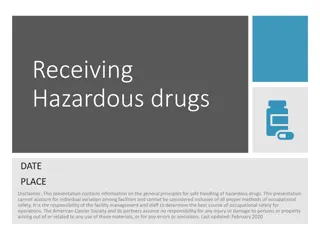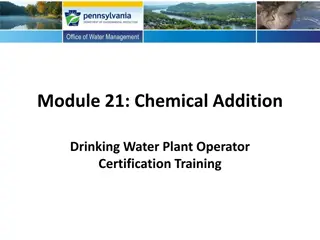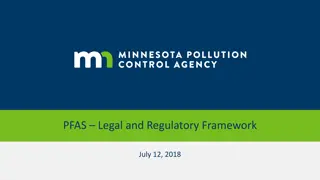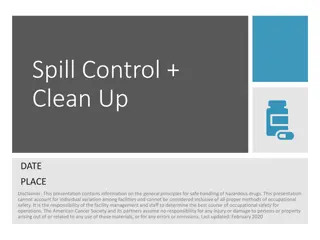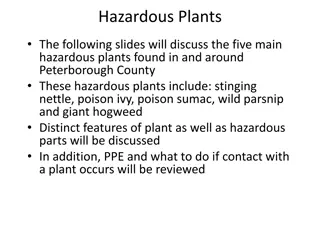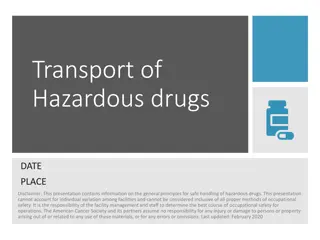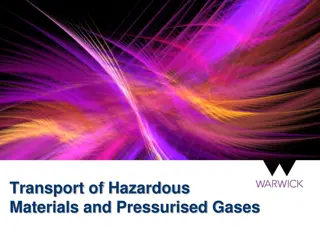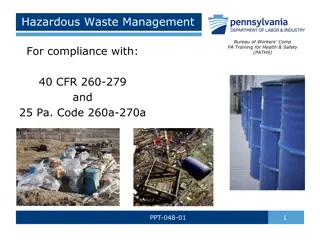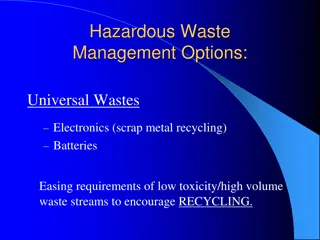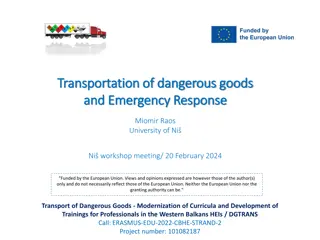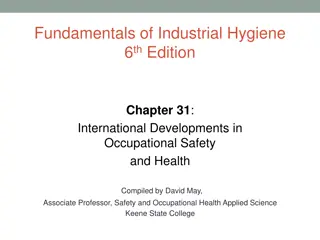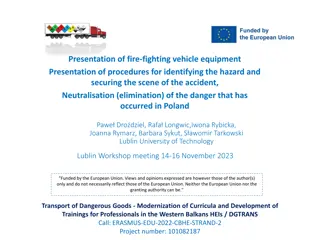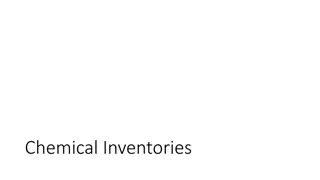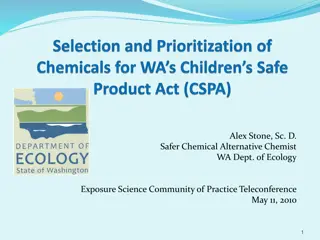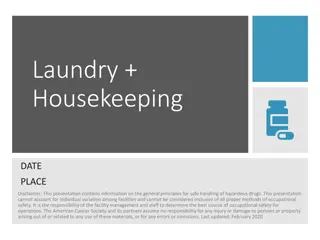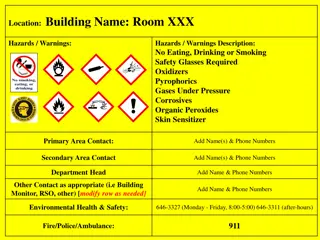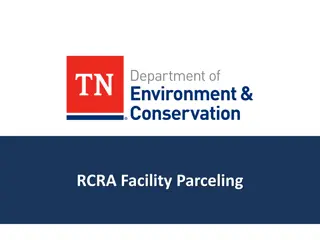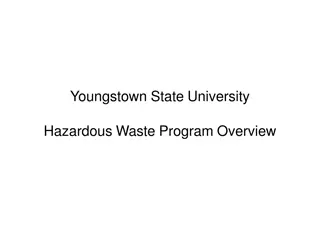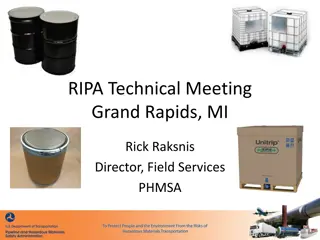Green Chemistry Chemicals Market Size Report, 2022-2029
The green chemicals market is expected to reach $217.18 billion by 2029 at a CAGR of 11.6% from 2022 to 2029. The growth of this market is driven by the scarcity of non-renewable resources, growing awareness regarding sustainable products, rising government initiatives to promote the use of green ch
2 views • 4 slides
Chemical Safety
Dr. Anu George emphasizes the importance of developing a chemical safety plan for handling hazardous substances. The plan includes components like hazard communication, proper labeling, MSDS availability, safe storage and disposal practices, employee training, incident reporting, and record-keeping.
0 views • 43 slides
Emergency Services Unit and Hazardous Materials Management in Louisiana
The Emergency Services Unit (ESU) in Louisiana, along with Hazardous Materials management, focuses on preparing, preventing, responding, recovering, and mitigating hazardous incidents. Their goals include public safety through education, training, enforcement, and support of regulations at the state
5 views • 35 slides
PP Jumbo Bags in Hazardous Material Handling
In industries dealing with hazardous materials, safety is paramount. From chemical manufacturing to waste management, proper containment and transportation of hazardous substances are critical to prevent accidents, protect workers, and comply with regulations. This is where PP jumbo bag step in as i
4 views • 5 slides
Overview of Heavy Chemicals Manufacturing Process
The field of industrial chemistry involves the large-scale preparation of heavy chemicals, which are chemicals produced and used commercially. This process requires an understanding of various physico-chemical principles and specific manufacturing techniques for chemicals like Ammonia, Sulphuric Aci
1 views • 30 slides
Occupational Exposure to Hazardous Drugs: Risks and Prevention
Learn about the hazards of exposure to hazardous drugs, including potential health risks such as cancer, nausea, reproductive toxicity, and organ damage. Explore training modules, drug categories, and a list of hazardous drugs to ensure workplace safety. Discover NIOSH criteria for identifying hazar
1 views • 42 slides
Hazardous Drug Cleaning and Decontamination Training Overview
This presentation provides an overview of training on deactivating, decontaminating, cleaning, and disinfecting hazardous drug areas. It covers essential steps, personal protective equipment, materials, timing, and validation criteria. All areas handling hazardous drugs must undergo deactivation, de
0 views • 23 slides
Streamlining Chemical Inventory Management with UC Chemicals
This project plan focuses on transitioning existing chemical inventories into UC Chemicals system to address challenges with outdated information and database discrepancies. The UC Chemicals application offers real-time updates, assists first responders, and simplifies inventory reconciliation using
0 views • 21 slides
Proposed Amendments for Hazardous Material Release Reporting Regulations
Amendments to the hazardous material release reporting regulations include consolidating definitions, adding new definitions, changing the administering agency, updating citations, and altering notification timeframes. The amendments aim to enhance emergency response and improve reporting procedures
1 views • 18 slides
Best Practices for Laboratory Safety and Management
Promoting a safe laboratory environment involves following safety codes and assigning responsibilities for practices like hazard awareness, equipment use, and PPE. Good laboratory practices include proper storage and handling of hazardous chemicals, with a focus on flammable, corrosive, reactive, an
3 views • 17 slides
Aroma Chemicals Market Expected to Soar with Surge in Organic and Natural Produc
Aroma Chemicals Market; By Source(Synthetic, Natural, Natural-Identical), By Products(Benzenoids, Terpenes and Terpenoids, Musk Chemicals, Others) (Ketones, Esters, Aldehydes), Application, Flavors, Convenience Foods, Confectionery, Dairy Products, B
0 views • 4 slides
Hazardous Materials Awareness Training Overview
This training module provides essential information on shipping and receiving hazardous materials, including definitions, objectives, levels of training required, shipping regulations, and penalties for non-compliance. It covers the importance of training, regulatory guidelines, and the potential co
0 views • 21 slides
Geomechanical Effects of Oilfield Chemicals on Sand Failure in Reservoir Rocks
This study by Elizabeth O. Wuyep et al. explores the geomechanical effects of oilfield chemicals on sand failure in reservoir rocks. It discusses the role of oilfield chemicals, limitations of previous works, experimental flow chart, and static saturation tests. The research emphasizes the need for
0 views • 25 slides
Hazardous Materials Business Plan Training Program
Facilities subject to the Hazardous Materials Business Plan (HMBP) Program must implement a training program for employees on hazardous materials safety and emergency response. This includes initial training for new employees within 30 days of hire and annual refresher training. Training covers safe
1 views • 73 slides
Insights into Specialty Chemicals Industry: Perstorp Plantwide Control
Explore the intricacies of specialty chemicals plants through the lens of Perstorp's experience, covering topics such as control objectives, degrees of freedom, and characteristics of these complex facilities. Discover the unique challenges and considerations in controlling processes for specialty c
0 views • 38 slides
Safe Handling of Hazardous Drugs: Training and Protocols
This presentation provides guidelines for the safe handling of hazardous drugs during receipt and unpacking. It covers topics such as personal protective equipment, inspecting packages for damage, and proper unpacking procedures. Staff involved in medication handling from suppliers should undergo th
0 views • 16 slides
Chemical Addition in Drinking Water Treatment Plant Certification Training
Learn about the essential topics of chemical addition in water treatment, including the types of chemicals used, safety measures, dosage calculations, and feed systems. Explore the importance of coagulating chemicals and their role in promoting particle aggregation for effective water treatment. Dis
0 views • 133 slides
Overview of PFAS Legal and Regulatory Framework
This document outlines the legal and regulatory framework surrounding PFAS (per- and polyfluoroalkyl substances), including hazardous waste designation, historical context at 3M sites, and the definition of hazardous substances and waste according to Minnesota statutes. It also discusses the potenti
0 views • 19 slides
Hazardous Drugs Spill Control and Clean-Up Guidelines
Learn about safe handling of hazardous drugs through spill control and clean-up procedures. This presentation covers identifying spills, using spill kits, cleaning spills, reporting, and documentation. Proper training and procedures are essential to protect personnel from exposure risks. Always foll
0 views • 27 slides
Hazardous Plants Identification and Safety Guide
Explore the five main hazardous plants found in and around Peterborough County, including stinging nettle, poison ivy, poison sumac, wild parsnip, and giant hogweed. Learn about their distinct features, hazardous parts, symptoms of contact, and safety precautions. Discover how to identify these plan
0 views • 4 slides
Safe Handling of Hazardous Drugs: Training Overview
This presentation provides essential information on safe handling practices for transporting hazardous drugs within healthcare facilities. It covers training modules, types of transport activities, personal protective equipment requirements, packaging guidelines, and safety criteria for labeling and
0 views • 17 slides
Understanding Hazardous Materials Transportation Regulations
Legislation governs the transportation of hazardous materials, including strict rules for packaging and transport. Dangerous goods are classified into nine categories, each with specific hazards. Consignors must identify, label, and package goods properly to prevent risks. Biological materials requi
0 views • 9 slides
Hazardous Waste Management Regulations in Pennsylvania
The hazardous waste management regulations in Pennsylvania outline compliance standards for handling hazardous waste, including storage, identification, transportation, recordkeeping, and emergency response. These regulations incorporate both federal guidelines under RCRA and state-specific requirem
0 views • 122 slides
Effective Hazardous Waste Management Strategies for Electronics and Batteries
Implementing proper waste management strategies for electronics and batteries is crucial to promote recycling and prevent environmental harm. The policy outlines procedures for disposing of electronic waste, including the collection of usable equipment for surplus handling. Additionally, it emphasiz
0 views • 9 slides
Proper Handling and Disposal of Hazardous Drugs and Waste
Guidelines for the safe handling and disposal of hazardous drugs and waste in healthcare facilities. The content covers training modules, waste collection, sources of healthcare waste, disposal methods, and legal regulations related to the disposal of hazardous drugs. Various types of healthcare was
0 views • 21 slides
Laboratory Safety Regulations and Guidelines for Chemistry Students
Strict safety measures have been enforced in the chemistry department at UCLA due to recent accidents, leading to the introduction of new safety rules for handling chemicals. This includes bans on certain solvents, implementation of PPE requirements, and adherence to a specific dress code. The empha
0 views • 8 slides
Modernization of Curricula for Transportation of Hazardous Materials and Emergency Response Workshop
This workshop, funded by the European Union, focuses on modernizing curricula and developing training programs for professionals in the Western Balkans HEIs on the transportation of dangerous goods and emergency response. Various methods of transporting hazardous materials, such as cargo tanks, chem
0 views • 35 slides
Environmental Aspects of Pharmaceutical Industry in India
The pharmaceutical industry in India poses various environmental hazards through manufacturing processes, handling of hazardous chemicals, waste disposal, and natural calamities. Hazardous waste types, sources of hazards, and examples of chemical waste highlight the importance of implementing effect
0 views • 31 slides
Importance of Hazard Communication Training for Workplace Safety
Hazard communication training is essential for creating a safe work environment by helping individuals recognize and manage hazardous materials effectively. Understanding the Globally Harmonized System (GHS) and following hazard communication laws can improve workplace safety, protect human health,
0 views • 36 slides
Global Harmonized System of Classification and Labeling of Chemicals (GHS) Overview
The Global Harmonized System of Classification and Labeling of Chemicals (GHS) was developed to address the inconsistencies in hazard information for chemicals globally due to significant trade. The history, mandate, and provisions of GHS, along with additional domestic harmonization efforts, are di
0 views • 29 slides
Proper Procedures for Dealing with Hazardous Substance Spills
This presentation covers the procedures for identifying and securing hazards at the scene of an accident, as well as neutralizing dangers in Poland. It includes information on fire-fighting vehicle equipment, such as different nozzles and tools used by the fire brigade. Steps for dealing with hazard
0 views • 7 slides
Building a Comprehensive Chemical Inventory System
Conduct a thorough review of all processes to identify and document all chemicals used on-site, create a standardized inventory with relevant information, and use the inventory to prioritize hazardous chemicals for substitution, track usage quantities, and streamline purchasing practices to prevent
0 views • 7 slides
Regulation of Chemicals in Children's Products for Safety
Massive safety concerns arose in 2007 due to high lead levels in toys, leading to legislation like the Children's Safe Product Act in WA. The Act restricted lead, cadmium, and phthalates in children's products, with a focus on Chemicals of High Concern to Children (CHCCs). The implementation involve
0 views • 27 slides
Hazardous Waste Pharmaceuticals Proposed Rule Overview
This briefing provides an in-depth look at the Hazardous Waste Pharmaceuticals Proposed Rule from October 20, 2015. It covers which pharmaceuticals are considered hazardous waste, major provisions of the proposal, examples of listed hazardous waste pharmaceuticals, and the flow of hazardous waste ph
0 views • 40 slides
Occupational Safety Training in Handling Hazardous Drugs
This presentation provides guidelines and training modules for staff responsible for cleaning areas where hazardous drugs are handled, including laundry and housekeeping tasks. Topics cover personal protective equipment recommendations, cleaning procedures, disposal processes, and hygiene practices.
0 views • 18 slides
Hazardous Materials Safety Guidelines for Room XXX in Building
This document outlines the hazardous materials safety guidelines for Room XXX in the building, highlighting prohibitions on eating, drinking, and smoking, as well as the requirement for safety glasses. It includes contact information for primary and secondary area contacts, the department head, and
0 views • 4 slides
Hazardous Waste Facility Parceling Process
Hazardous Waste Facility Parceling involves subdividing permitted facilities into separate property tracts to facilitate ownership transfers. The process allows for the transfer of portions of the property, including hazardous waste management units, with specific actions and requirements for new ow
0 views • 5 slides
Guidelines and Regulations for Science and Engineering Fair Projects
Ensure completeness of required forms before conducting any experimentation for the Collier Regional Science and Engineering Fair. Local rules take precedence over state and international rules. Projects involving vertebrate animals, hazardous biological agents, or chemicals require approval from th
0 views • 13 slides
Youngstown State University Hazardous Waste Program Overview
The Hazardous Waste Program at Youngstown State University follows a cradle-to-grave approach, encompassing laws, regulations, inspections, roles, and responsibilities related to hazardous waste management. It delves into the identification, labeling, disposal, and transportation of hazardous waste,
0 views • 18 slides
RIPA Technical Meeting Grand Rapids, MI
The Pipeline and Hazardous Materials Safety Administration's (PHMSA) strategic framework emphasizes innovation and safety in transportation of energy and hazardous materials. Goals include cultivating excellence, building trust, and pursuing operational excellence. Initiatives such as IBC repair tes
0 views • 11 slides






